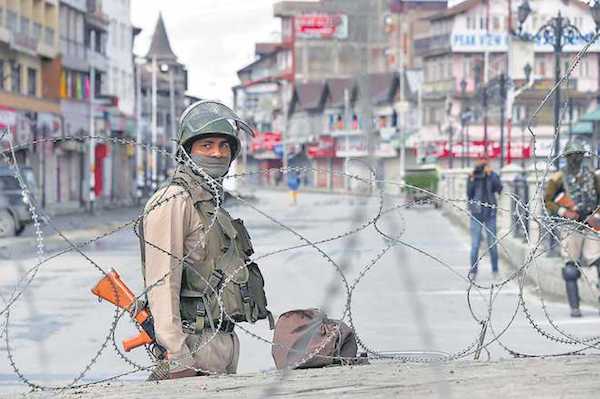
By Arun Joshi
The state is hurting. Some degree of sensitivity and a ‘highly disciplined’ approach will possibly yield better results. The security forces must remain calm in the event of any provocation.
Kashmiris happy, somewhat. The PDP-BJP split was much awaited; by people who were unable to reconcile to the rule of the saffron party by proxy. Fear was deeply entrenched in the minds of the locals that right-wing Hindutva forces, with the high pitch for the abrogation of Article 370, may succeed in undermining Kashmir’s special status. Naturally, Kashmiri Muslims were insecure after the alliance came about. And so, it became easier to support the forces of violence, as for them, the PDP had committed an unpardonable sin by shaking hands with the BJP; and getting nothing in return. The first shocker came when the Centre delayed the flood relief package by more than a year after the devastating floods in the autumn of 2014, a couple of months before the Assembly elections that year.
The PDP-BJP government has disappeared from the corridors of power, but the apprehensions of Kashmiris have not. Aware of political expediencies and vulnerabilities of the parties, they suspect more political compromises may be in the offing. They are waiting and watching the developments very closely. The street mood will be determined by the governance they get, and the way they are treated at their homes, and out on the streets. Kashmiris have become hyper-sensitive about their identity and dignity — siding with secessionist forces is a manifestation of that emotion.
Some voices in the BJP are linking a ‘hard approach’ toward militants as a way of pulling out Kashmir from the vicious cycle of violence it finds itself in. They believe the militants would/should be hunted and neutralized but forget that this approach prevailed earlier too, and nothing came of it.
What is really needed is to take into account the attendant pressing matters that have come into play over the past two years — the civilian population, mostly youth with rocks thronging encounter sites and disrupting anti-militancy operations; and the clashes that follow as a result of accidental civilian killings, or what is seen as ‘collateral damage’. Over these two years, the civilian population has identified itself with militants, primarily for two reasons. First, many militants are locals. They are boys they saw in the neighborhood, hence the affinity which exists in the well-knit Muslim society.
Second, they do not perceive the violent acts as being out of sync with their newly-acquired ethos of resistance. It is a big shift — this ‘new-found’ relationship between the civilians and the militants. In the 1990s, the militants were seen as mujahideen (warriors). There were no doubts. They had picked up the gun and should be ready for the consequences — to die fighting the security forces. Sympathy and sentiment was surely with them, but it was not manifested in the desperate and visible attempts to save them while risking their own lives; as we see now. This is the fundamental truth of the changed situation in Kashmir. The psyche of the common Kashmiri has undergone a sea change.
Today, the way of looking at the militants has changed, almost hero-like: their arms training may be limited to few weeks, even less, but they are hardened. They have shown their will and grit to fight unto the last. What is more, there is societal approval of their ‘sacrifices’. Some of them have spurned appeals of their parents to return home.
Some extraordinary real-life visuals have paled the reel-life images — the mother of Saddam Padder, a top militant of Shopian in South Kashmir recently killed in an encounter, giving a gun salute to her slain son. Her gesture left a deep impact on the minds of youngsters who watched the video that went viral on social media; and is seen as a universal endorsement of militancy by their mothers.
In such circumstances, reckless actions, with the rhetoric of hard approach, (BJP general secretary Ram Madhav has distanced his party from it) — without taking into account the fallout — have the potential to blow up in the face. The way forward should be specific operations without making much noise. It will help keep civilians out of harm’s way. This is important, because there is widespread impression that the security forces will be striking hard, not necessarily a militant-specific action. It will be deemed as an action against the people who would come to defend them. Stone-throwers will not only seek to disrupt the cordon and search operations — a prelude to the actual gunfight with militants — but also attack patrol parties.
This phenomenon is interlinked. Militants attack convoys of security forces even as stone-throwers use tactics to distract, thereby creating situations where the Army and police either suffer casualties or inflict casualties. At times, both sides suffer casualties, speeding up the cycle of killings.
Kashmir-centric parties, the PDP and the National Conference are convinced that the hard approach is not the answer to the problem. Other ways can be found to ease the situation without making the hard approach visible: the security forces must change their attitude towards the public at large. Treating the common Kashmiri with contempt and suspicion will only breed a psyche of resistance and rebellion. A highly disciplined approach would yield better results. Effort should be made to stay calm in the event of any provocation.
The past cannot be reversed, but the future can be built on, with a new and sophisticated approach.
(The author can be reached at ajoshi57@gmail.com)





Be the first to comment